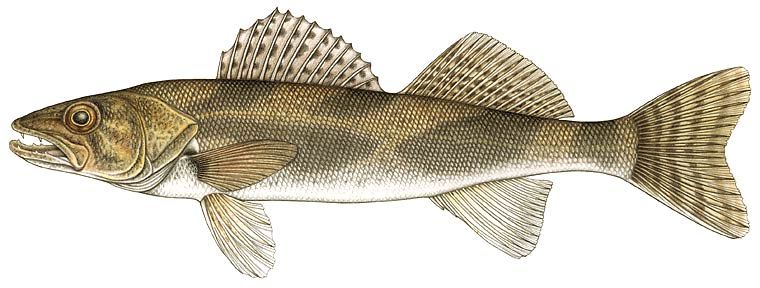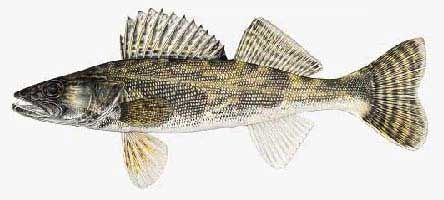Re: Son's Mud Eye
In my opinion, walleye are the sissiest of all fresh water fish. A blue gill will put up a better fight then an walleye. I think this is what you guys caught John_S and also what you guys have over in England are these but probably a saugeye.<br /><br />Life History Notes: <br />SAUGER <br /><br />

<br /><br />COMMON NAMES: Sauger, Jack salmon <br /><br />SCIENTIFIC NAME: Sander canadense <br /><br />IDENTIFICATION: Sauger look very similar to walleye and saugeye. The body is cylindrical with dark blotches along the sides. They have sharp canine teeth and large cloudy eyes. They can be distinguished from walleye by the large dark spots on the spiny dorsal fin.<br /><br />RANGE AND HABITAT: The sauger is native to Ohio and can be found in the Ohio River, Lake Erie and its tributaries. They prefer large, turbid slow moving rivers, and large, cool shallow lakes.<br /><br />LIFE HISTORY: Sauger spawn in the spring when water temperatures reach the upper 40s. Females lay between 10,000 to 50,000 eggs. The eggs are adhesive and stick to vegetation, sticks, and stones until they hatch in 10 days or more. Sauger prefer to forage for aquatic insects, crayfish, and small fishes during periods of low light (dawn and dusk).<br /><br />ADULT SIZE: Most sauger range from 9 to 15 inches in length and are less than 1 pound. The state record fish weighs 7 pounds, 5 ounces and is 24.5 inches long.<br /><br />FISHING METHODS: Lead head jigs, minnows, or crankbaits fished near the bottom are often productive sauger bait. Tailwaters below dams on the Ohio River and major tributaries are the best areas. Late and early fall are the most productive times of the year.<br /><br />See Ohio River Report<br /> <br />© 2005 ODNR, Division of Wildlife<br /> <br />OR<br /><br />Life History Notes: SAUGEYE <br />COMMON NAME: Saugeye <br /><br />

<br /><br />SCIENTIFIC NAME: Sander vitreus x Sander canadense <br /><br />IDENTIFICATION: Saugeye are a cross of the walleye and sauger. The dark bars on the dorsal fin are the best identifying characteristic for this fish. Sharp canine teeth, dark blotches on the sides, and a white tip on the lower tail also help identify the saugeye.<br /><br />RANGE AND HABITAT: Saugeye have been stocked into many impoundments in Ohio. They can also be found in streams and rivers below stocked impoundments. Saugeye are highly adaptable to most lake and river environments and are tolerant of turbid waters.<br /><br />LIFE HISTORY: Saugeye are created by crossing walleye eggs with sperm from a sauger. The result is a fast growing fish that has excellent survival abilities. This also makes it ideal for stocking into Ohio reservoirs and rivers; however, saugeye can create some problems. Generally, most hybrid species do not reproduce, but saugeye do occasionally reproduce with walleye and sauger. This can create genetic problems in the fishery.<br /><br />ADULT SIZE: Saugeye average 1 pound and range between 13 and 16 inches in length. The state record fish weighed 12.42 pounds.<br /><br />FISHING METHODS: Many saugeye are caught in tailwater areas downstream from the impoundments where they have been stocked. Crankbaits, lead headed jigs with hair, feathers, or plastic tails are good artificial lures. Live minnows and nightcrawlers are also productive. Winter is an excellent time to catch saugeye. See our chart on when to catch saugeye by season.

























